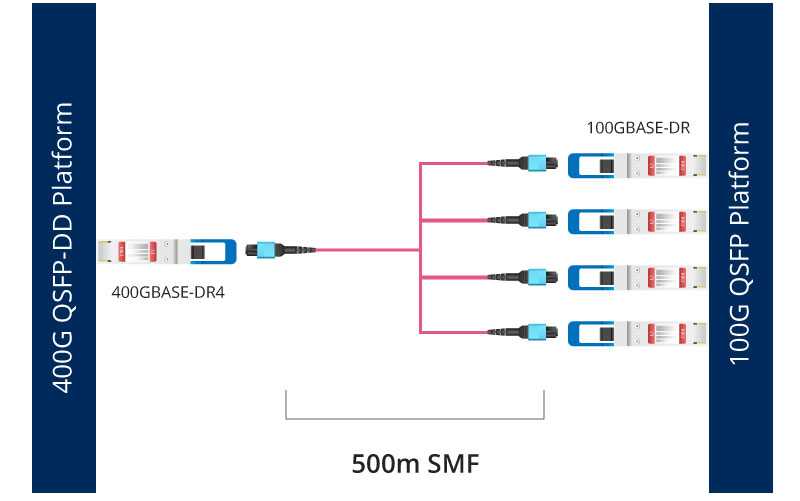100G Single Lambda Offers Cost-Effective 100GE and 400GE Solutions
Although optical transceivers operating at 100 Gb/s like 100GBASE-LR4, 100G-CWDM4, 100G-PSM4, and 100GBASE-SR4 are already available in the market. But to reduce the total cost and to obtain higher transmission efficiency, a 100G Single Lambda transceiver specification has been proposed. This article will give you an in-depth introduction to 100G Single Lambda from the definition, comparison with the common 100G QSFP28, performance, and development prospects.
What Is 100G Single Lambda?
Single Lambda 100G is an optical specification using PAM4 signaling to transmit 100G data streams through a single wavelength. The specifications, defined by 100G Lambda MSA, are developed around an optical channel data rate of 100Gb/s, aiming to unlock a cost-effective solution for high-density multi-terabit switching, routing, and transport networks. Transceivers using this specification use 100G PAM4 signaling at 100G per wavelength, reducing optical complexity and cost by reducing the number of optical transmitters and receivers from four to one.
100G Single Lambda vs the Common 100G QSFP28: Differences and Advantages
Simpler Structure
The single-λ 100G optics include the 100G DR, 100G FR, 100G ER and 100G LR. These transceivers take a 4x 25G electrical signal from the host and convert the signal to PAM4 modulation using a DSP, meaning that the entire 100G data stream is transmitted by a single laser. Compared to the common 100G QSFP28 modules, 100G Single Lambda transceivers eliminate the need for WDM or parallel fiber and reduce the number of optical components needed, such as transmitters and receivers from four to one.

Longer Transmission Distance
The 100G QSFP28 DR was specified for 500-meter links. The 100G Lambda MSA extended the reach of 100GBASE-FR to 2 km, enabling use for longer links and infrastructure including a higher number of patch panels or just higher loss environments. The MSA has extended coverage to 10 km with 100GBASE-LR, addressing the same applications as the 100G QSFP28 LR4 modules.
Lower Cost
100G Single Lambda not only reduces the complexity of the optical components but also provides cheaper 100G links. According to IEEE, the ability to support 100G per λ (wavelength) can reduce the cost of 100GE optical signals by at least 40% with a single optical path. This means that the transition from 4 wavelengths/lambda to 1 wavelength/lambda reduces the relative cost by more than 40%.

How Will 100G Single Lambda Facilitate 400G?
As traffic continues to grow, the need for simpler, more cost-effective pluggable optical modules will become the key to transceiver market development, especially in high-speed and high-density applications like 200G and 400G. Single Lambda 100G makes the transition from 100G to 400G applications easier and reduces the internal complexity of 400G modules, which is more conducive to the development of 100G Ethernet to higher data rates such as 400G. At the same time, the fiber count is reduced, which contributes to cost savings.
100G Single Lambda: A Path to Upgrade From 100G QSFP28 to 400G QSFP-DD
Since PAM4 modulation has made single-lane 100G possible, upgrading from 100G to 4x 100G has become a reality. For example, the IEEE leveraged 100GBASE-DR for the 400GBASE-DR4 optical standard. The 400GBASE-DR4 could break out into four parallel 100GBASE-DR modules and provide 400G connectivity over 500m. With 100G Single Lambda transceivers, 400G ports can be easily implemented through 100G breakout connections.

100G Single Lambda Makes 400G Modules More Economical
The 100G Lambda MSA group also helps upgrade the existing IEEE 400G standards. In the existing 400G standards, the 400G transceivers rely on 8 lanes of 50G PAM4 optical signals on the LAN-WDM wavelength grid, which has the same issues as 100GBASE-LR4 explained above. The number of wavelength channels required and the complexity of the multiplexer and demultiplexer seem costly. Realizing such shortcomings, the 100G Lambda MSA decided to use 100G per wavelength instead of 50G and use four channels on the CWDM wavelength grid with a wider window of tolerance, which provides a lower-cost path for 400G.
Conclusion
100G Single Lambda, developed by 100G Lambda MSA, enables a cost-effective solution for the deployment of 100G Ethernet and facilitates the upgrade from 100G to 400G. Besides, Single Lambda 100G optics provide significant advantages in terms of transmission distance and cost compared to the common 100G QSFP28 modules. Therefore, 100G Single Lambda can be a new preferred option for 100G and 400G networks.
You might be interested in
Email Address

-
PoE vs PoE+ vs PoE++ Switch: How to Choose?
Mar 16, 2023















